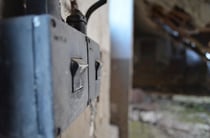Over the past several months, it has been proven that HVAC systems play a role in the mitigation of the spread of a virus like COVID-19. The first line of defense – personal masking and social distancing – is by far the most effective in mitigation, but we’ve learned a lot about HVAC’s contribution to keeping people safe indoors. My last blog covered the why & how of ventilation (fresh air). In this blog I want to focus on ventilation control strategies: why & how the industry evolved from pre-pandemic minimalization, to early-pandemic wind tunnel 24/7, to a common sense, balanced approach on ventilation control.
 Pre-PandemiC Minimizing
Pre-PandemiC Minimizing Early Pandemic Over-Use
Early Pandemic Over-Use Current Balance
Current Balance
I also refer you to Jamie Hand’s last blog on ventilation airflow calculation methodology which highlights how to determine the industry’s recommendation for minimum airflow rates. Look for future blogs from Cx Associates on filtration and lessons we learned from implementing these mitigation recommendations.
Evolving Ventilation Control Strategies: Pre-pandemic
 Energy engineers and controls contractors have spent years dialing in HVAC control strategies to satisfy the needs of the building’s occupants in the most energy efficient manner possible. Pre-pandemic commercial and institutional buildings with separate ventilation and temperature conditioning (heating and cooling) equipment, for example, were often optimized to operate on different schedules. A building could use its baseboard or heat pump systems to bring a building up to temperature from, say, 5:30 am until 10:00pm so that the few people in the building early or late would remain comfortable. However, the ventilation (through air handling units and energy recovery units) was often not started until 9:00am and turned off at 7:00pm, as that was when the occupancy rate was such that full ventilation was required. Also, many air handling units (AHU) had demand control ventilation (DCV) that modulated ventilation airflow dependent on space CO2 levels – if buildings were lightly occupied, the AHU would reduce the ventilation amount until the CO2 levels rose with increased occupancy. Such strategies optimized ventilation by modulating the amount to meet the needs of the building while reducing the energy consumption of the systems. Conversely, air handling units (AHUs) or terminal units (unit ventilators and fancoil units) that conducted both ventilation and conditioning (heating/cooling) often modulated their fans based on space temperature. Often, when the space temperatures were satisfied, the fans providing airflow and air changes were turned off, even during hours of high occupancy.
Energy engineers and controls contractors have spent years dialing in HVAC control strategies to satisfy the needs of the building’s occupants in the most energy efficient manner possible. Pre-pandemic commercial and institutional buildings with separate ventilation and temperature conditioning (heating and cooling) equipment, for example, were often optimized to operate on different schedules. A building could use its baseboard or heat pump systems to bring a building up to temperature from, say, 5:30 am until 10:00pm so that the few people in the building early or late would remain comfortable. However, the ventilation (through air handling units and energy recovery units) was often not started until 9:00am and turned off at 7:00pm, as that was when the occupancy rate was such that full ventilation was required. Also, many air handling units (AHU) had demand control ventilation (DCV) that modulated ventilation airflow dependent on space CO2 levels – if buildings were lightly occupied, the AHU would reduce the ventilation amount until the CO2 levels rose with increased occupancy. Such strategies optimized ventilation by modulating the amount to meet the needs of the building while reducing the energy consumption of the systems. Conversely, air handling units (AHUs) or terminal units (unit ventilators and fancoil units) that conducted both ventilation and conditioning (heating/cooling) often modulated their fans based on space temperature. Often, when the space temperatures were satisfied, the fans providing airflow and air changes were turned off, even during hours of high occupancy.
Additionally, exhaust fans typically operated intermittently, based on occupancy – either through a manual switch or an occupancy sensor.
Evolving Ventilation Control Strategies: Early Pandemic
Early in the pandemic, there were very few studies conducted on the spread of the COVID-19 virus and everyone was panicking. So, they threw the kitchen sink in just to be safe. In April and May of 2020, ASHRAE and the CDC recommended ventilation fans operate 24/7, exhaust fans operate 24/7, energy recovery wheels be removed, DCV controls disabled, and outside air dampers be fully opened. Energy efficiency was completely disregarded. Not that we’re blaming anyone! This is new for all of us and we were sure of one thing: over ventilation is definitely better than underventilation.
Evolving Ventilation Control Strategies: Current
About the middle of the summer in 2020, the CDC and ASHRAE pulled back on their no-holds-barred ventilation control strategies recommendations. They realized many AHUs and energy recovery ventilators (ERVs) were not designed to condition that much outside air and there was a risk of equipment failure (such as freezing coils) and uncomfortable supply air temperatures leading to uncomfortable occupants. The high energy costs were also an important consideration.
By this time in the pandemic, the CDC and ASHRAE had run tests on the effects of ventilation and air movement with respect to virus particle movement and virus viability. Since then, the recommendations for ventilation control strategies are generally along these lines:
- Balance ventilation airflow to meet full occupancy levels as per ASHRAE Standard 62.1
Calculate and balance outside air dampers, terminal unit dampers, and fan speeds to provide the full occupancy ventilation airflow for each space within a building. Please refer to Jamie Hand’s last blog on this methodology. Although no one has a crystal ball as to what amount of fresh air will guarantee a safe space, spaces rarely experience full occupancy and this amount of fresh air is likely quite safe. - Run ventilation fans longer - 2 hours before and after occupancy and all through occupancy
Operate the fans at full occupancy ventilation levels for two hours before and after occupancy to allow the building to be ‘purged’ of any aerosols brought in by the occupants. In my example above, this would mean that the ventilation would operate continuously at full occupancy levels from 7:00am to 9:00pm, if occupancy is from 9:00am – 7:00pm. Instead of allowing ventilation fans to turn off when space temperatures are satisfied during the occupied hours, the fans need to be programmed to remain operational with a neutral discharge air temperature.
- Run bathroom exhaust fans on same schedule as ventilation fans
Instead of operating all exhaust fans with occupancy switches or 24/7, this balanced approach calls to operate the exhaust fans continuously for the same hours as the ventilation fans. This purges the air and keeps the bathrooms at a negative pressure to the rest of the building. This prohibits virus particulates from migrating into the hallways and the occupied spaces. Although bathrooms in commercial and institutional buildings are not occupied continuously, the reason for this control strategy is that this is an area where people from different spaces overlap and are therefore more exposed to aerosols.
- Lower CO2 setpoints
Instead of decommissioning DCV controls, if a space has existing DCV controls, ASHRAE is recommending reducing the CO2 setpoint to 700-900ppm. Typical pre-pandemic CO2 levels were approximately 900-1200ppm. Adjusting the levels to this lower setpoint will keep the outside air damper open and increase the amount of ventilation air. As a side note, we strongly urge building owners to have their CO2 sensors calibrated. Cx Associates has often found even new CO2 sensors to be out of calibration and this could be dangerous if the AHU controls are based on these sensors.
- Use heat recovery units or economizers when adding ventilation
For buildings with AHUs that recirculate building airflow or do not currently have a ventilation system, we strongly encourage the installation of an ERV as this provides ventilation in the most energy efficient manner. If an ERV is not possible, economizers are also recommended as they enable an increase in ventilation during auspicious outside air conditions.
Pandemic Mode Control Button
 Several controls contractors are being asked to reprogram building automation systems (BAS) from their optimized energy efficient sequences to these pandemic sequences. It would be a real shame to lose these optimized sequences as we will, hopefully, be able to return to the efficient operations in the future. For this reason, we recommend asking the controls contractor to reprogram the pandemic sequences with a ‘Pandemic Mode’ button on the BAS interface. This enables the building operator to switch the control sequences themselves between the ‘normal’ (efficient) operation and the ‘pandemic’ operation in the future.
Several controls contractors are being asked to reprogram building automation systems (BAS) from their optimized energy efficient sequences to these pandemic sequences. It would be a real shame to lose these optimized sequences as we will, hopefully, be able to return to the efficient operations in the future. For this reason, we recommend asking the controls contractor to reprogram the pandemic sequences with a ‘Pandemic Mode’ button on the BAS interface. This enables the building operator to switch the control sequences themselves between the ‘normal’ (efficient) operation and the ‘pandemic’ operation in the future.


